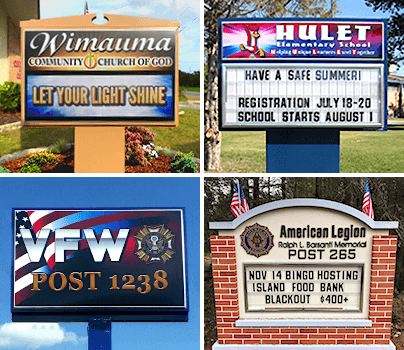If you're investing in a sign for your church, school, town, a non-profit organization, or business, you want to ensure the sign stands the test of time. High-quality materials and expert installation processes help to make that possible, but you also need to consider wind loads. Keep reading to learn more about wind loads, how they affect signs and what signs need to withstand the wind.
What Are Wind Loads?
Wind load refers to the amount of pressure the wind places on the exterior of a structure or an object. When a stationary object prevents wind from blowing past it, the energy in the wind transforms into pressure which acts as a force against the fixed object. The wind is measured in pounds per square inch or other types of weight measurements per cubic volume. Wind loads can vary drastically, and they directly correlate with the speed of the wind - the faster the wind blows, the higher the wind loads become. For example, an 80mph wind produces wind loads of about 16 psf2, while 100 mph winds have about 25 psf2 of wind load.
What Affects Wind Loads?
The speed of the wind is not the only factor that determines wind loads. The impact of the force also varies based on the structure's position, shape, and orientation to the wind. Objects and structures around the sign also affect the wind load because they act as wind breakers.
For example, signs in suburban, urban, and wooded areas are likely to experience lower wind loads than signs in open or rural areas in the same climate with the same wind patterns. While designing your sign and identifying the right type of foundation, quality sign manufacturers consider the presence of hurricanes, tornadoes, and other weather events in your area. They also need to consider atmospheric pressure, terrain, temperatures, wind gusts, and a variety of other elements.
How to Protect from Wind Damage
Wind exists all over, but differences in weather patterns and the factors noted above, the risk is not the same in every area. Work with a sign professional who can assess the risk of wind damage in your area and ensure the materials, design and installation can withstand the potential wind loads. Signs need to feature high quality, durable materials, and they need to be strengthened in areas where pieces are likely to come apart in heavy winds. Signs should have engineered foundations and be set up to resist all types of wind load.
What are the Wind Zones in the United States?
The United States consists of four different wind zones. Zone I features all the land west of the Rocky Mountains, and the top wind speeds in this area tend to be about 130 mph. In Zone II, winds reach speeds of 160 mph, and this area contains most of the Rocky Mountains, the northern parts of the country, and a significant portion of the Northeastern United States. Zone III boasts the rest of the country except for a small section in the middle which constitutes Zone IV. In Zone III, winds get up to 200 mph, while in Zone IV, they can blow at 250 mph, making this area the part of the country that has the highest wind loads. To get a detailed look at these zones and to figure out your zone, check out the map from the Federal Emergency Agency (FEMA).
At Stewart Signs, we take wind loads seriously when designing our signs. When Hurricane Katrina brought 125 mph winds, a Stewart Sign at the Franklin Avenue Baptist Church emerged from three weeks underwater working perfectly. There are countless other stories of sign's surviving extreme wind loads and significant weather events. To talk with a sign consultant about your needs, contact us today.
